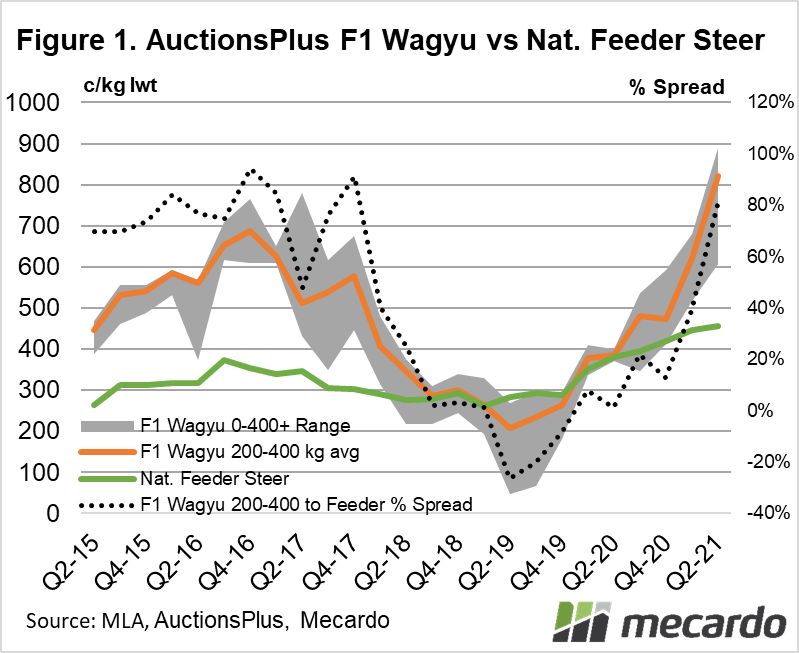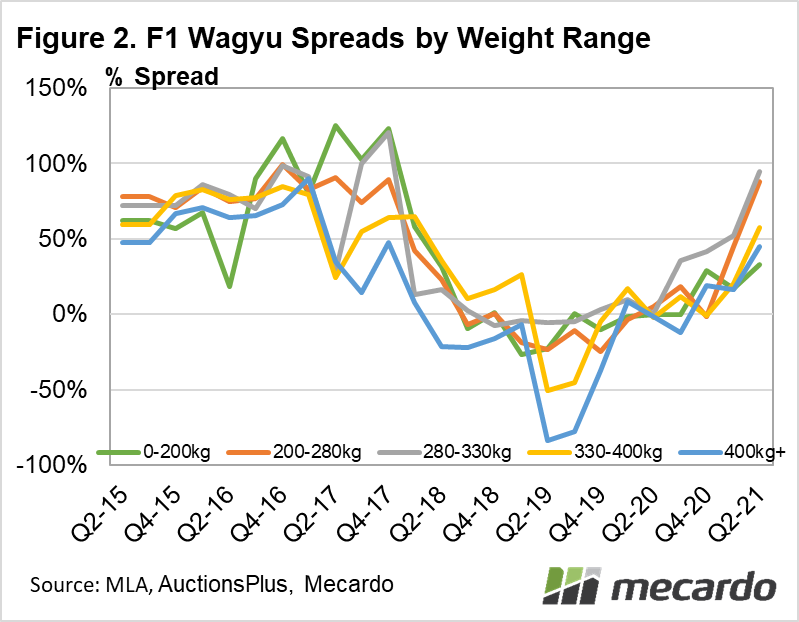Wagyu cattle are considered the world’s most desirable and expensive source of beef, with quality Australian ribeye steaks currently being advertised at upwards of $300 a kilo in the US. After suffering a major collapse between 2018 and 2019, Australian F1 Wagyu cattle premiums on AuctionsPlus have recovered to a level of 80% above the national feeder steer indicator.
Australian F1 Wagyu cattle are again achieving very solid prices, at an 80% premium above the feeder steer indicator level on Auctionsplus. Five years ago, back in 2015, it was the norm for F1 Wagyu Steers listed on AuctionsPlus to achieve eyewatering prices in excess of 70-80% above the national feeder steer indicator.
This premium collapsed rapidly between 2018 and 2019, (figure 1), bottoming out at -30% discount in March 2019, before mounting a steady recovery up to the present day. That’s even despite the impact of COVID-19 on foodservice throughout 2020.
AuctionsPlus data reveals that the vast majority of F1 Wagyu steers that are listed via the online sale channel can be attributed to Angus bloodlines, averaging over 70% of yardings since 2015. 2019 and 2020 saw a varied variety of Wagyu crossbreeds entering the market, including Wagyu Herefords, Fresians and Murray Grays.
The collapse in the Wagyu premium on AuctionsPlus back in 2018/19 has been attributed to an oversupply issue, where some producers made attempts to enter the marketplace with non-Angus Wagyu crossbreeds.
The Australian Wagyu cattle market is considered to be a highly specialised, niche product, where the individual body differences and breeding in particular Wagyu cattle can attract significant price differentials. Looking at figure 2, animal weight can have impacts on value, where heavier steers of 400kg+ lwt typically attract a lower premium, but also, very light <200kg cattle too. Mid-range 280-330kg steers attract the most consistent value advantage.
The SA government states that in excess of 80% of Australian Wagyu production is exported to the US, where retail prices can reach over $300/kg. Other key markets for Australian Wagyu include China, South Korea, and also Japan, where its local industry is unable to meet the demand generated by the estimated 60% of the population who regularly consume Wagyu.
Australia holds the world’s largest Wagyu herd outside of Japan, at 83,000 head as of 2016. A point of difference for Australian Wagyu product is the AUS-Meat grading system which can clearly showcase strong intramuscular fat marbling scores to customers.
What does it mean?
Wagyu cattle generally attract a premium, but this isn’t always the case, illustrated by the collapse of Wagyu premiums into a negative range back in mid-2019 which is thought to be supply-driven as too many producers entered Wagyu production.
Australia’s meat grading system also provides a helpful marketing advantage when competing against domestic US Wagyu beef.
Have any questions or comments?
Key Points
- The average Wagyu premium over feeder steers has reached 80%
- Premiums are highly variable based on specification
- Mid-range 280-330kg lwt weights fetch the highest premiums.
Click on figure to expand
Click on figure to expand
Data sources: AuctionsPlus,ABS, Mecardo, Australian Wagyu Association














